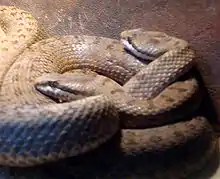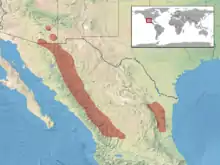Crotalus pricei
Crotalus pricei is a species of venomous snake, a pit viper in the family Viperidae. The species is endemic to the southwestern United States and northern Mexico. Two subspecies are recognized, including the nominate subspecies described here.[5]
| Crotalus pricei | |
|---|---|
 | |
| Scientific classification | |
| Kingdom: | Animalia |
| Phylum: | Chordata |
| Class: | Reptilia |
| Order: | Squamata |
| Suborder: | Serpentes |
| Family: | Viperidae |
| Genus: | Crotalus |
| Species: | C. pricei |
| Binomial name | |
| Crotalus pricei Van Denburgh, 1895 | |
 | |
| Synonyms | |
| |
Etymology
The specific name, pricei, is in honor of William Wightman "Billy" Price (1871–1922), a field biologist, who collected the first specimens which became the type series.[6][7][8]
Description
Adults of C. pricei usually do not exceed 50–60 cm (about 20–24 in) in total length (including tail). The maximum total length recorded is 66 cm (26 in).[3]
The color pattern consists of a gray, bluish-gray, brownish-gray, or medium- to reddish-brown ground color, usually with a fine brown speckling. This is overlaid with a series of dorsal blotches that tend to be divided down the median line to form 39-64 pairs.[3]
Common names
Common names for C. pricei include twin-spotted rattlesnake,[3] western twin-spotted rattlesnake,[4] Price's rattlesnake, Arizona spotted rattlesnake, spotted rattlesnake,[9] and Arizona twin-spotted rattlesnake.[10]
Geographic range
C. pricei is found in the United States in southeastern Arizona. In northern Mexico, it occurs in the Sierra Madre Occidental in Sonora, Chihuahua, and Durango. It has also been found in the Sierra Madre Oriental in southeastern Coahuila, Nuevo León, and Tamaulipas, with isolated records in San Luis Potosí and Aguascalientes. The type locality given is "Huachua Mts., Arizona" (Cochise County, Arizona, United States).[2]
Conservation status
This species, C. pricei, is classified as Least Concern on the IUCN Red List of Threatened Species (v3.1, 2001).[1] Species are listed as such due to their wide distribution, presumed large population, or because they are unlikely to be declining fast enough to qualify for listing in a more threatened category. The population trend was stable when assessed in 2007.[11]
Subspecies
| Subspecies[5] | Taxon author[5] | Common name[4] | Geographic range[2] |
|---|---|---|---|
| C. p. miquihuanus | Gloyd, 1940 | Eastern twin-spotted rattlesnake | Mexico: southeastern Coahuila, Nuevo León and Tamaulipas |
| C. p. pricei | Van Denburgh, 1895 | Western twin-spotted rattlesnake | United States: southeastern Arizona, Mexico: Sonora, Chihuahua and Durango |
References
- Hammerson GA, Vazquez Díaz J, Quintero Díaz GE (2007). "Crotalus pricei". IUCN Red List of Threatened Species. 2007. Retrieved 5 June 2017.CS1 maint: uses authors parameter (link) CS1 maint: ref=harv (link)
- McDiarmid RW, Campbell JA, Touré TA (1999). Snake Species of the World: A Taxonomic and Geographic Reference, Volume 1. Washington, District of Columbia: Herpetologists' League. 511 pp. ISBN 1-893777-00-6 (series). ISBN 1-893777-01-4 (volume).
- Campbell JA, Lamar WW (2004). The Venomous Reptiles of the Western Hemisphere. Ithaca and London: Comstock Publishing Associates. 870 pp., 1500 plates. ISBN 0-8014-4141-2.
- Klauber LM (1997). Rattlesnakes: Their Habitats, Life Histories, and Influence on Mankind. Second Edition. First published in 1956. Berkeley: University of California Press. ISBN 0-520-21056-5.
- "Crotalus pricei ". Integrated Taxonomic Information System. Retrieved 1 August 2007.
- Moll, Edward O. (2003). "Patronyms of the Pioneer West, V. Crotalus pricei Van Denburgh, 1895 – Twin-spotted rattlesnake". Sonoran Herpetologist. 16 (12): 110–112.
- Beolens, Bo; Watkins, Michael; Grayson, Michael (2011). The Eponym Dictionary of Reptiles. Baltimore: Johns Hopkins University Press. xiii + 296 pp. ISBN 978-1-4214-0135-5. (Crotalus pricei, p. 211).
- Fisher, Walter K. (March 1923). "William Wightman Price" (PDF). The Condor. 25: 50–57. doi:10.2307/1362900.
- Wright AH, Wright AA (1957). Handbook of Snakes of the United States and Canada. (7th printing, 1985). Ithaca and London: Comstock Publishing Associates. 1,105 pp. (in 2 volumes). ISBN 0-8014-0463-0.
- Brown JH (1973). Toxicology and Pharmacology of Venoms from Poisonous Snakes. Springfield, Illinois: Charles C. Thomas. 184 pp. LCCCN 73-229. ISBN 0-398-02808-7.
- 2001 Categories & Criteria (version 3.1) at the IUCN Red List. Accessed 13 September 2007.
Further reading
- Behler JL, King FW (1979). The Audubon Society Field Guide to North American Reptiles and Amphibians. New York: Alfred A. Knopf. 743 pp. ISBN 0-394-50824-6. (Crotalus pricei, p. 691 + Plate 637).
- Hubbs, Brian; O'Connor, Brendan (2012). A Guide to the Rattlesnakes and other Venomous Serpents of the United States. Tempe, Arizona: Tricolor Books. 129 pp. ISBN 978-0-9754641-3-7. (Crotalus pricei pricei, pp. 62–63).
- Schmidt KP, Davis DD (1941). Field Book of Snakes of the United States and Canada. New York: G.P. Putnam's Sons. 365 pp. (Crotalus triseriatus pricei, p. 306).
- Smith HM, Brodie ED Jr (1982). Reptiles of North America: A Guide to Field Identification. New York: Golden Press. 240 pp. ISBN 0-307-13666-3. (Crotalus pricei, pp. 206–207).
- Stebbins RC (2003). A Field Guide to Western Reptiles and Amphibians, Third Edition. The Peterson Field Guide Series ®. Boston and New York: Houghton Mifflin Company. xiii + 533 pp. ISBN 978-0-395-98272-3. (Crotalus pricei, p. 417 + Plate 52 + Map 184).
- Van Denburgh, J (1895). "Description of a new rattlesnake (Crotalus pricei) from Arizona". Proc. Calif. Acad. Sci. 2. 5: 856–857.
External links
| Wikimedia Commons has media related to Crotalus pricei. |
- Crotalus pricei at the Reptarium.cz Reptile Database. Accessed 12 December 2007.
